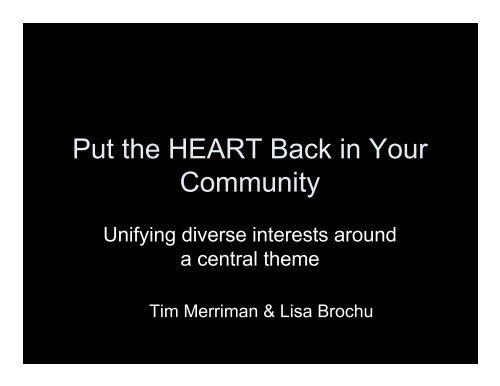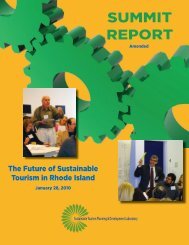Download PDF - Sustainable Tourism Lab
Download PDF - Sustainable Tourism Lab
Download PDF - Sustainable Tourism Lab
Create successful ePaper yourself
Turn your PDF publications into a flip-book with our unique Google optimized e-Paper software.
Put the HEART Back in Your<br />
Community<br />
Unifying diverse interests around<br />
a central theme<br />
Tim Merriman & Lisa Brochu
Convergent Evolution in<br />
Community Planning<br />
• Civic <strong>Tourism</strong><br />
• Scenic Byways<br />
• Experience Economy<br />
• <strong>Sustainable</strong> Communities
Civic<strong>Tourism</strong>.org - Reframing<br />
<strong>Tourism</strong><br />
• Rethink Economics<br />
• Connecting to the Public<br />
• Invest in the Story
Scenic Byways<br />
• Intermodal Surface Transportation<br />
Efficiency Act (1991)<br />
• Corridor Management Plans<br />
• 2005<br />
– 8 All-American Roads<br />
– 125 Scenic Byways in 44 states<br />
– 175 Million Dollars in grants
Pine & Gilmore’s Experience<br />
Economy Theory<br />
• Agriculture economy<br />
• Manufacturing economy<br />
• Service economy<br />
• Experience economy<br />
– Theme the experience<br />
– Harmonize impressions<br />
– Eliminate negative cues<br />
– Mix in memorabilia<br />
– Engage all five senses
Sustainability Definitions<br />
• Brundtland Report - Our Common<br />
Future (1987)<br />
• “Development which meets the needs of<br />
the present without endangering the<br />
ability of future generations to meet their<br />
own needs.”
<strong>Sustainable</strong> Seattle (1991)<br />
• Triple bottom line planning<br />
• Collaborative planning<br />
• Indicators of sustainability
Sustainability Indicators
Sustainability Indicators
Definition of Interpretation<br />
A mission-based<br />
communication process<br />
that forges emotional and<br />
intellectual connections<br />
between the interests of<br />
the audience and the<br />
meanings inherent in the<br />
resource.
The care of rivers is not a<br />
question of rivers but of the<br />
human heart.<br />
Tanaka Shozo<br />
Stewardship<br />
Care for<br />
Care about<br />
Understanding<br />
Awareness<br />
Curiosity<br />
Dragged Along<br />
Social Marketing - The Interpretive Continuum
Definition of Interpretive<br />
Planning<br />
A thoughtful decision making process<br />
that blends management needs and<br />
resource considerations with visitor<br />
desires and ability to pay to determine<br />
the most effective way to communicate<br />
a message to targeted markets in<br />
support of the agency’s mission.<br />
Lisa Brochu
5-M Interpretive Planning<br />
Model<br />
Management<br />
Message<br />
Media<br />
Markets<br />
Mechanics
Management<br />
• mission, goals, objectives (logic models)<br />
• policies & regulations<br />
• key issues<br />
• revision and update strategies<br />
• operational resources<br />
– staffing<br />
– budget<br />
– facilities & equipment<br />
– maintenance
Markets<br />
• product - what you have to offer<br />
• price - perceived value<br />
• place - relationship to what’s around<br />
• promotion - how do people know about<br />
you<br />
• publics - market segmentation<br />
– users & support<br />
– existing & potential
Message<br />
• Why is this site significant?<br />
• What interests visitors?<br />
Resource<br />
Management<br />
Markets<br />
• What is management most<br />
interested in communicating?
Mechanics<br />
Large Scale Design Balance<br />
– Site or landscape features<br />
– Facilities and buildings<br />
– Interpretive stories
Mechanics<br />
Smaller scale<br />
– Functional relationships<br />
– Accessibility<br />
– Space programming<br />
– Placement<br />
– Physical opportunities &<br />
constraints<br />
– Maslow’s Hierarchy
Media<br />
• Publications<br />
• Signs<br />
• Exhibits<br />
• Souvenirs<br />
• Food items<br />
• Visitor centers<br />
• Auto tours<br />
• Guided tours<br />
<br />
<br />
<br />
<br />
<br />
<br />
<br />
<br />
Products for children<br />
Demonstrations<br />
Living history<br />
Audio tours<br />
Landscape features<br />
Art & sculpture<br />
Playscapes<br />
Promotional materials
Interpretive Planning Fills in<br />
the Blanks<br />
• Community-Wide Involvement<br />
• Visitor Experience Design based on<br />
Logic Models<br />
• Interpretive Guide and Host Training
Sphere of Influence<br />
Interpretive planning works for:<br />
– Individual sites or programs<br />
– Community wide thematic approaches<br />
– Regional or Corridor approaches
Put the HEART Back in Your Community<br />
• Holistic<br />
• Emotional<br />
• Appropriate<br />
• Rewarding<br />
• Thematic
Civic Engagement Strategies<br />
• Public input meetings<br />
• Public hearings<br />
• Focus groups<br />
• Community Coalitions
• Holistic (mechanics) (TM)<br />
Holistic<br />
• Community experience plans (CEP)<br />
• Considers community mechanics<br />
• Respects local traditions
Decision<br />
Visitor Experience Model<br />
Entry<br />
Connections<br />
Exit<br />
Commitment
Emotionalthrough media<br />
- Process worksheets (what is the thing you have at home and what’s the story behind it)<br />
• Making connections<br />
• Advertising approaches<br />
• Keepsakes
Appropriate<br />
• Authenticity<br />
• Audience-oriented
Rewarding<br />
Determine rewards<br />
- stakeholders<br />
- community<br />
- residents<br />
- visitors<br />
• Rewarding (management) (LB)<br />
- rewards for stakeholders, community at large, visitors<br />
- logic model objectives (measuring reward for community and visitors) LB<br />
- process worksheets<br />
Logic Models<br />
- outputs (what we do)<br />
- outcomes (behavior changes or what happens as<br />
a result)<br />
- impacts (benefits to the community or community<br />
resources)
Thematic<br />
• Research-based<br />
– Ausubel (1960)<br />
– Thorndyke (1979)<br />
– Miller (1954)<br />
– Cowan (2000)
Traits of a Theme<br />
• Complete Sentence - idea or message<br />
• Answers “So what?”<br />
• Connects tangibles to intangibles<br />
(universals)<br />
• Specific and interesting
Getting Started<br />
• Whose project is it?<br />
• What results are desired?<br />
– Benefits (impacts) to the community or resources?<br />
– Visitor behavior (outcomes) that will support<br />
benefits?<br />
• How do we achieve those results?<br />
– What media (outputs) to use?
For More Information<br />
• Put the HEART back in your Community<br />
(heartfeltpublications.com)<br />
• Interpretive Planning: The 5-M Model for<br />
Successful Planning Projects<br />
(www.interpnet.com)<br />
• National Association for Interpretation<br />
(www.interpnet.com)<br />
• Tim Merriman and Lisa Brochu<br />
(naiexec@aol.com, naiprograms@aol.com)





